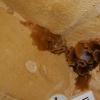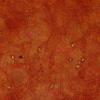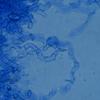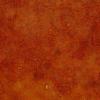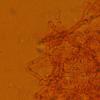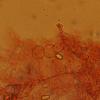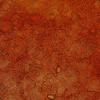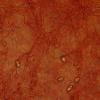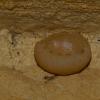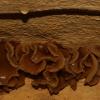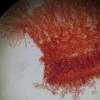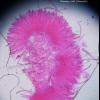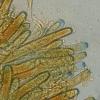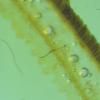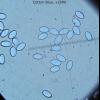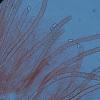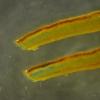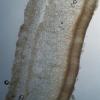
06-12-2025 00:19
 Viktorie Halasu
Viktorie Halasu
Hello, would anyone have this article, please? An

05-12-2025 17:33
 Bruno Coué
Bruno Coué
Bonjour, je serais heureux de recueillir votre avi

02-12-2025 18:59
This pair of ascos 2.5cm across were on recently b

02-12-2025 19:25
Buckwheat PeteHello, can anyone identify this hairy fungus growi

30-11-2025 12:53
 Edvin Johannesen
Edvin Johannesen
White short-stipitate apothecia found on thin twig

30-11-2025 10:47
 William Slosse
William Slosse
I recently found a collection of small Peziza sp.
Peziza domiciliana or varia (and a parasite fungus)
Stephen Martin Mifsud,
17-02-2017 21:03
 Hi, I wonder if this is interesting to someone here.
Hi, I wonder if this is interesting to someone here.Recently I have collected a large population of clustered Peziza domiciliana on a limestone wall. I have placed this in the fridge and went to examine it today. I noticed that on the abaxial surface, there was a layer of another mould-like fungus, quite hard and compact, almost as if encrusted that it literally pealed off from the surface of the Peziza
I gave it a quick shot under the microscope and it was obvious to be a parasitic fungus. It is difficult to describe but it consisted of tightly intertwined curled hyphae which here and there, it produced swellings (glubular hyphae) which I think has a sexual function.
I am dropping all images here, and if you have some comments or perhaps a genus (or family) I would love to learn
Thanks in advance
Lothar Krieglsteiner,
18-02-2017 08:57

Re : Fungal parasite on Peziza domiciliana
Hi Stephen and others,
I cannot say much about the possible parasite - so I don`t.
The Peziza I would possibly have called P. cerea (muralis) by pure macroscopy and ecologal condtions, but I don`t know much about the taxonomy today and about the limits to similar species (varia, domiciliana?).
Best regards from Lothar
René Dougoud,
18-02-2017 10:43
Re : Fungal parasite on Peziza domiciliana
Bonjour chers Collègues,
Oui, il s'agit très probablement de Peziza varia (= P. cerea, P. micropus, et de très probablement de P. muralis). Cette espèce est assez communément récoltée sur des murs humides. S'agissant des hyphes, je ne pense pas qu'il s'agit d'un parasite, mais plutôt d'une prolifération anormalement abondante d'hyphes de l'excipulum ectal, peut être la conséquence d'un stress ou des conditions locales.
Cordialement
René
Oui, il s'agit très probablement de Peziza varia (= P. cerea, P. micropus, et de très probablement de P. muralis). Cette espèce est assez communément récoltée sur des murs humides. S'agissant des hyphes, je ne pense pas qu'il s'agit d'un parasite, mais plutôt d'une prolifération anormalement abondante d'hyphes de l'excipulum ectal, peut être la conséquence d'un stress ou des conditions locales.
Cordialement
René
Stephen Martin Mifsud,
18-02-2017 19:42

Re : Fungal parasite on Peziza domiciliana
Dr. Dougoud translation:
Yes, it is most likely Peziza varia (= P. cerea, P. micropus, and most likely P. muralis). This species is commonly harvested on damp walls. As for the hyphae, I do not think it is a parasite, but rather an abnormally abundant proliferation of hyphae of ectal excipulum, may be the result of stress or local conditions .
Yes, it is most likely Peziza varia (= P. cerea, P. micropus, and most likely P. muralis). This species is commonly harvested on damp walls. As for the hyphae, I do not think it is a parasite, but rather an abnormally abundant proliferation of hyphae of ectal excipulum, may be the result of stress or local conditions .
Stephen Martin Mifsud,
18-02-2017 19:56

Re : Fungal parasite on Peziza domiciliana
Thank you for you help and feedback. I have done full microscopy of the Peziza and here are the results:
Habitat: Wet Limestone wall (Globigerina Limestone)
Habitat notes: Room with water literally dripping from the wall
Remarks: Numerous clustered specimens of various sizes
Acocarp colour (adaxial): Young specimens are pale buff, semitranslucent then gradually turning toffee brown when fully mature
Acocarp colour (abaxial): Beige to pale buff when wet but ccustose cream or almost white when dry
Ascocarp diameter: 30 – 95 mm (mean: 60.42 mm)
Ascocarp rim: Irregularly lobed and sinusoidal especially in adult specimens
Ascocarp shape: Initially bowl shaped when young and rather regular then flattening out to a saucer- shape with an irregular border, ocassionally trumpet shaped.
Stipe length: Stipe absent
Stipe colour: Stipe absent
Texture Smooth: to finely granulose
Flesh colour: Buff, semi-hyaline
Additional notes: Five layers detected; hymenium, a thin subhymenium, medullary excipulum, ectal excipulum and an outer abaxial epithilial layer
PARAPHYSES.
Paraphyses: Numerous in dense clusters
Paraphyses shape (apex): Not differentiated, or very slightly inflated
Paraphyses width: 5-7 µm, ocassionally inflated to 10-15um at the middle
Paraphyses length: 70–80 µm, distinctly shorter from the asci
Paraphyses septation: Two or more septa, usually up to five
Few paraphyses are inflated about the middle part, wile others have conspicuous vacuoles that do not stain in congo red, melzer or Cotton blue
ASCI
Ascospore release: Apical orifice without operculum
Shape: Cylindrical, slender, arcuate
No. of Spores: 8
Operculum: Not observed
Tunic (Wall): Unitruncate
Ascum length (range): 205.49 - 286.82 µm
Ascum length (mean): 254 µm
Ascum width (range): 10 - 14.28 µm
Ascum width (mean): 12.1 µm
Ascum L:W ratio: 21.1
Iodine reaction (J +/J -): Strongly J+ve at the tips. Apart from the asci tips, the subhymenium and young asci also stain blue in Melzer
ASCOSPORES
Spore length (range): 12.29 - 14.85 µm
Spore length (mean): 13.3 µm
Spore width (range): 7.11 - 8.92 µm
Spore width (mean): 8.0 µm
Spore Q factor (range): 1.52 - 2.04 µm
Spore Q factor (mean): 1.7
Spore shape: Oval
Spore septa: 0
Spore surface: Finely rough, appearing as cloudiness under x 1000
Oil bodies Not observed
Ascocarp Layers 6: A whitish hymenium, sitting on a narrow and darker layer subhymenium composed small pigmented hyphae (and possily giving the brownish colour of the ascocarp). Below is the spongy medullary excipulum and then the ectal excipulum separated by a thin pigmented layer of tubular hyaphae. An epithilial tissue is finally found at the abaxial surface and is composed of small globular cells
Excipulum layers: 2 , separated at the lower quarter by a thin layer of textura intricata of short tubular hyphae 7-10um wide.
Medullary Excipulum: Spongy thick layer of textura angulosa, 40-70um wide
Ectal Excipulum: Narrow layer of tessuta angulosa, 20-50um wide.
Abaxial epithilium Thin crustose layer of inticated hyphae with several swellings
Habitat: Wet Limestone wall (Globigerina Limestone)
Habitat notes: Room with water literally dripping from the wall
Remarks: Numerous clustered specimens of various sizes
Acocarp colour (adaxial): Young specimens are pale buff, semitranslucent then gradually turning toffee brown when fully mature
Acocarp colour (abaxial): Beige to pale buff when wet but ccustose cream or almost white when dry
Ascocarp diameter: 30 – 95 mm (mean: 60.42 mm)
Ascocarp rim: Irregularly lobed and sinusoidal especially in adult specimens
Ascocarp shape: Initially bowl shaped when young and rather regular then flattening out to a saucer- shape with an irregular border, ocassionally trumpet shaped.
Stipe length: Stipe absent
Stipe colour: Stipe absent
Texture Smooth: to finely granulose
Flesh colour: Buff, semi-hyaline
Additional notes: Five layers detected; hymenium, a thin subhymenium, medullary excipulum, ectal excipulum and an outer abaxial epithilial layer
PARAPHYSES.
Paraphyses: Numerous in dense clusters
Paraphyses shape (apex): Not differentiated, or very slightly inflated
Paraphyses width: 5-7 µm, ocassionally inflated to 10-15um at the middle
Paraphyses length: 70–80 µm, distinctly shorter from the asci
Paraphyses septation: Two or more septa, usually up to five
Few paraphyses are inflated about the middle part, wile others have conspicuous vacuoles that do not stain in congo red, melzer or Cotton blue
ASCI
Ascospore release: Apical orifice without operculum
Shape: Cylindrical, slender, arcuate
No. of Spores: 8
Operculum: Not observed
Tunic (Wall): Unitruncate
Ascum length (range): 205.49 - 286.82 µm
Ascum length (mean): 254 µm
Ascum width (range): 10 - 14.28 µm
Ascum width (mean): 12.1 µm
Ascum L:W ratio: 21.1
Iodine reaction (J +/J -): Strongly J+ve at the tips. Apart from the asci tips, the subhymenium and young asci also stain blue in Melzer
ASCOSPORES
Spore length (range): 12.29 - 14.85 µm
Spore length (mean): 13.3 µm
Spore width (range): 7.11 - 8.92 µm
Spore width (mean): 8.0 µm
Spore Q factor (range): 1.52 - 2.04 µm
Spore Q factor (mean): 1.7
Spore shape: Oval
Spore septa: 0
Spore surface: Finely rough, appearing as cloudiness under x 1000
Oil bodies Not observed
Ascocarp Layers 6: A whitish hymenium, sitting on a narrow and darker layer subhymenium composed small pigmented hyphae (and possily giving the brownish colour of the ascocarp). Below is the spongy medullary excipulum and then the ectal excipulum separated by a thin pigmented layer of tubular hyaphae. An epithilial tissue is finally found at the abaxial surface and is composed of small globular cells
Excipulum layers: 2 , separated at the lower quarter by a thin layer of textura intricata of short tubular hyphae 7-10um wide.
Medullary Excipulum: Spongy thick layer of textura angulosa, 40-70um wide
Ectal Excipulum: Narrow layer of tessuta angulosa, 20-50um wide.
Abaxial epithilium Thin crustose layer of inticated hyphae with several swellings
Stephen Martin Mifsud,
18-02-2017 20:11

Re : Fungal parasite on Peziza domiciliana
Regards the alleged/suspected parasite, I can say that the specimen was stored at 5C (fridge) for a week and so this maybe caused the ectal excipulum to harden and react differently, but I thought those swollen, sphere-shaped hyphae attached to an intricate mycelium of curved hyphae were an alien fungus.
Impressively, when I blew on the ascocarp collection placed in a container, I could see a puff of white spores - FEW seconds later! Its like there is a mechanism involving the paraphyses. Also when I dropped some Iodine (or water) on the surface, the fruiting body ejected spores which could be seen as cloudy puffs floating in the air!!! Incredible!
Impressively, when I blew on the ascocarp collection placed in a container, I could see a puff of white spores - FEW seconds later! Its like there is a mechanism involving the paraphyses. Also when I dropped some Iodine (or water) on the surface, the fruiting body ejected spores which could be seen as cloudy puffs floating in the air!!! Incredible!
Stephen Martin Mifsud,
19-02-2017 18:18

Re : Fungal parasite on Peziza domiciliana
Sorry for persisting, but at this stage I wish to label the Peziza, either P. varia (=muralis) or domiciliana. I read that Peziza varia should have a few (or several?) layers of hypahe transversally - this specimen had a hymenium and a thin subhymenium, two major layers of excipulum, the one below the hymenium thick, the other (medullar exicipulum) narrower and both textura angularis, these seperated by a very thin and pigmented layer of texture intricate. Finally an abaxial epithilium layer (I exchanged this as a mould of different origin) which becomes thick and with swollen hyphae in adverse conditions. Interestingly there was a bluish coloration of the excipulum with Iodine solution.
The habitat of varia is quite diverse but mostly on the ground not walls, where P. domiciliana is a wall specialist.
http://www.mycocharentes.fr/pdf1/489.pdf
The habitat of varia is quite diverse but mostly on the ground not walls, where P. domiciliana is a wall specialist.
http://www.mycocharentes.fr/pdf1/489.pdf
